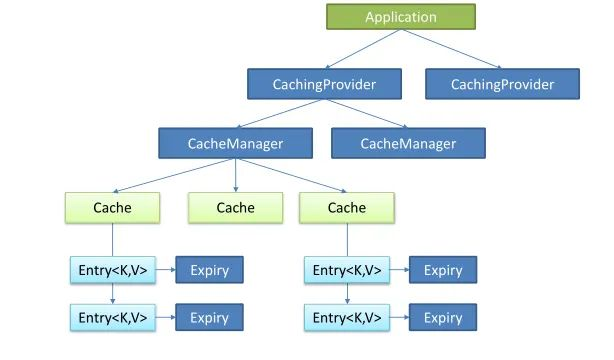SpringBoot 整合快取效能之王 Caffeine
使用快取的目的就是提高效能,今天碼哥帶大家實踐運用 spring-boot-starter-cache 抽象的快取元件去整合本地快取效能之王 Caffeine。
大家需要注意的是:in-memeory 快取只適合在單體應用,不適合與分散式環境。
分散式環境的情況下需要將快取修改同步到每個節點,需要一個同步機制保證每個節點快取資料最終一致。
Spring Cache 是什麼
不使用 Spring Cache 抽象的快取介面,我們需要根據不同的快取框架去實現快取,需要在對應的程式碼裡面去對應快取載入、刪除、更新等。
比如查詢我們使用旁路快取策略:先從快取中查詢資料,如果查不到則從資料庫查詢並寫到快取中。
虛擬碼如下:
public User getUser(long userId) {
// 從快取查詢
User user = cache.get(userId);
if (user != null) {
return user;
}
// 從資料庫載入
User dbUser = loadDataFromDB(userId);
if (dbUser != null) {
// 設定到快取中
cache.put(userId, dbUser)
}
return dbUser;
}
我們需要寫大量的這種繁瑣程式碼,Spring Cache 則對快取進行了抽象,提供瞭如下幾個註解實現了快取管理:
- @Cacheable:觸發快取讀取操作,用於查詢方法上,如果快取中找到則直接取出快取並返回,否則執行目標方法並將結果快取。
- @CachePut:觸發快取更新的方法上,與
Cacheable相比,該註解的方法始終都會被執行,並且使用方法返回的結果去更新快取,適用於 insert 和 update 行為的方法上。 - @CacheEvict:觸發快取失效,刪除快取項或者清空快取,適用於 delete 方法上。
除此之外,抽象的 CacheManager 既能整合基於本地記憶體的單體應用,也能整合 EhCache、Redis 等快取伺服器。
最方便的是通過一些簡單設定和註解就能接入不同的快取框架,無需修改任何程式碼。
整合 Caffeine
碼哥帶大家使用註解方式完成快取操作的方式來整合,完整的程式碼請存取 github:https://github.com/MageByte-Zero/springboot-parent-pom,在 pom.xml 檔案新增如下依賴:
<dependency>
<groupId>org.springframework.boot</groupId>
<artifactId>spring-boot-starter-cache</artifactId>
</dependency>
<dependency>
<groupId>com.github.ben-manes.caffeine</groupId>
<artifactId>caffeine</artifactId>
</dependency>
使用 JavaConfig 方式設定 CacheManager:
@Slf4j
@EnableCaching
@Configuration
public class CacheConfig {
@Autowired
@Qualifier("cacheExecutor")
private Executor cacheExecutor;
@Bean
public Caffeine<Object, Object> caffeineCache() {
return Caffeine.newBuilder()
// 設定最後一次寫入或存取後經過固定時間過期
.expireAfterAccess(7, TimeUnit.DAYS)
// 初始的快取空間大小
.initialCapacity(500)
// 使用自定義執行緒池
.executor(cacheExecutor)
.removalListener(((key, value, cause) -> log.info("key:{} removed, removalCause:{}.", key, cause.name())))
// 快取的最大條數
.maximumSize(1000);
}
@Bean
public CacheManager cacheManager() {
CaffeineCacheManager caffeineCacheManager = new CaffeineCacheManager();
caffeineCacheManager.setCaffeine(caffeineCache());
// 不快取空值
caffeineCacheManager.setAllowNullValues(false);
return caffeineCacheManager;
}
}
準備工作搞定,接下來就是如何使用了。
@Slf4j
@Service
public class AddressService {
public static final String CACHE_NAME = "caffeine:address";
private static final AtomicLong ID_CREATOR = new AtomicLong(0);
private Map<Long, AddressDTO> addressMap;
public AddressService() {
addressMap = new ConcurrentHashMap<>();
addressMap.put(ID_CREATOR.incrementAndGet(), AddressDTO.builder().customerId(ID_CREATOR.get()).address("地址1").build());
addressMap.put(ID_CREATOR.incrementAndGet(), AddressDTO.builder().customerId(ID_CREATOR.get()).address("地址2").build());
addressMap.put(ID_CREATOR.incrementAndGet(), AddressDTO.builder().customerId(ID_CREATOR.get()).address("地址3").build());
}
@Cacheable(cacheNames = {CACHE_NAME}, key = "#customerId")
public AddressDTO getAddress(long customerId) {
log.info("customerId:{} 沒有走快取,開始從資料庫查詢", customerId);
return addressMap.get(customerId);
}
@CachePut(cacheNames = {CACHE_NAME}, key = "#result.customerId")
public AddressDTO create(String address) {
long customerId = ID_CREATOR.incrementAndGet();
AddressDTO addressDTO = AddressDTO.builder().customerId(customerId).address(address).build();
addressMap.put(customerId, addressDTO);
return addressDTO;
}
@CachePut(cacheNames = {CACHE_NAME}, key = "#result.customerId")
public AddressDTO update(Long customerId, String address) {
AddressDTO addressDTO = addressMap.get(customerId);
if (addressDTO == null) {
throw new RuntimeException("沒有 customerId = " + customerId + "的地址");
}
addressDTO.setAddress(address);
return addressDTO;
}
@CacheEvict(cacheNames = {CACHE_NAME}, key = "#customerId")
public boolean delete(long customerId) {
log.info("快取 {} 被刪除", customerId);
return true;
}
}
使用 CacheName 隔離不同業務場景的快取,每個 Cache 內部持有一個 map 結構儲存資料,key 可用使用 Spring 的 Spel 表示式。
單元測試走起:
@RunWith(SpringRunner.class)
@SpringBootTest(classes = CaffeineApplication.class)
@Slf4j
public class CaffeineApplicationTests {
@Autowired
private AddressService addressService;
@Autowired
private CacheManager cacheManager;
@Test
public void testCache() {
// 插入快取 和資料庫
AddressDTO newInsert = addressService.create("南山大道");
// 要走快取
AddressDTO address = addressService.getAddress(newInsert.getCustomerId());
long customerId = 2;
// 第一次未命中快取,列印 customerId:{} 沒有走快取,開始從資料庫查詢
AddressDTO address2 = addressService.getAddress(customerId);
// 命中快取
AddressDTO cacheAddress2 = addressService.getAddress(customerId);
// 更新資料庫和快取
addressService.update(customerId, "地址 2 被修改");
// 更新後查詢,依然命中快取
AddressDTO hitCache2 = addressService.getAddress(customerId);
Assert.assertEquals(hitCache2.getAddress(), "地址 2 被修改");
// 刪除快取
addressService.delete(customerId);
// 未命中快取, 從資料庫讀取
AddressDTO hit = addressService.getAddress(customerId);
System.out.println(hit.getCustomerId());
}
}
大家發現沒,只需要在對應的方法上加上註解,就能愉快的使用快取了。需要注意的是, 設定的 cacheNames 一定要對應,每個業務場景使用對應的 cacheNames。
另外 key 可以使用 spel 表示式,大家重點可以關注 @CachePut(cacheNames = {CACHE_NAME}, key = "#result.customerId"),result 表示介面返回結果,Spring 提供了幾個後設資料直接使用。
| 名稱 | 地點 | 描述 | 例子 |
|---|---|---|---|
methodName |
根物件 | 被呼叫的方法的名稱 | #root.methodName |
method |
根物件 | 被呼叫的方法 | #root.method.name |
target |
根物件 | 被呼叫的目標物件 | #root.target |
targetClass |
根物件 | 被呼叫的目標的類 | #root.targetClass |
args |
根物件 | 用於呼叫目標的引數(作為陣列) | #root.args[0] |
caches |
根物件 | 執行當前方法的快取集合 | #root.caches[0].name |
| 引數名稱 | 評估上下文 | 任何方法引數的名稱。如果名稱不可用(可能是由於沒有偵錯資訊),則引數名稱也可在#a<#arg> where#arg代表引數索引(從 開始0)下獲得。 |
#iban或#a0(您也可以使用#p0或#p<#arg>表示法作為別名)。 |
result |
評估上下文 | 方法呼叫的結果(要快取的值)。僅在unless 表示式、cache put表示式(計算key)或cache evict 表示式(when beforeInvocationis false)中可用。對於支援的包裝器(例如 Optional),#result指的是實際物件,而不是包裝器。 |
#result |
核心原理
Java Caching定義了5個核心介面,分別是 CachingProvider, CacheManager, Cache, Entry 和 Expiry。

核心類圖:

- Cache:抽象了快取的操作,比如,get()、put();
- CacheManager:管理 Cache,可以理解成 Cache 的集合管理,之所以有多個 Cache,是因為可以根據不同場景使用不同的快取失效時間和數量限制。
- CacheInterceptor、CacheAspectSupport、AbstractCacheInvoker:CacheInterceptor 是一個AOP 方法攔截器,在方法前後做額外的邏輯,比如查詢操作,先查快取,找不到資料再執行方法,並把方法的結果寫入快取等,它繼承了CacheAspectSupport(快取操作的主體邏輯)、AbstractCacheInvoker(封裝了對 Cache 的讀寫)。
- CacheOperation、AnnotationCacheOperationSource、SpringCacheAnnotationParser:CacheOperation定義了快取操作的快取名字、快取key、快取條件condition、CacheManager等,AnnotationCacheOperationSource 是一個獲取快取註解對應 CacheOperation 的類,而SpringCacheAnnotationParser 是解析註解的類,解析後會封裝成 CacheOperation 集合供AnnotationCacheOperationSource 查詢。
CacheAspectSupport:快取切面支援類,是CacheInterceptor 的父類別,封裝了所有的快取操作的主體邏輯。
主要流程如下:
- 通過CacheOperationSource,獲取所有的CacheOperation列表
- 如果有@CacheEvict註解、並且標記為在呼叫前執行,則做刪除/清空快取的操作
- 如果有@Cacheable註解,查詢快取
- 如果快取未命中(查詢結果為null),則新增到cachePutRequests,後續執行原始方法後會寫入快取
- 快取命中時,使用快取值作為結果;快取未命中、或有@CachePut註解時,需要呼叫原始方法,使用原始方法的返回值作為結果
- 如果有@CachePut註解,則新增到cachePutRequests
- 如果快取未命中,則把查詢結果值寫入快取;如果有@CachePut註解,也把方法執行結果寫入快取
- 如果有@CacheEvict註解、並且標記為在呼叫後執行,則做刪除/清空快取的操作
今天就到這了,分享一些工作小技巧給大家,後面碼哥會分享如何接入 Redis ,並且帶大家實現一個基於 Sping Boot 實現一個 Caffeine 作為一級快取、Redis 作為二級快取的分散式二級快取框架。
我們下期見,大家可以在評論區叫我靚仔麼?不叫也行,點贊分享也是鼓勵。
參考資料
[1]https://segmentfault.com/a/1190000041640222
[2]https://docs.spring.io/spring-framework/docs/current/reference/html/integration.html